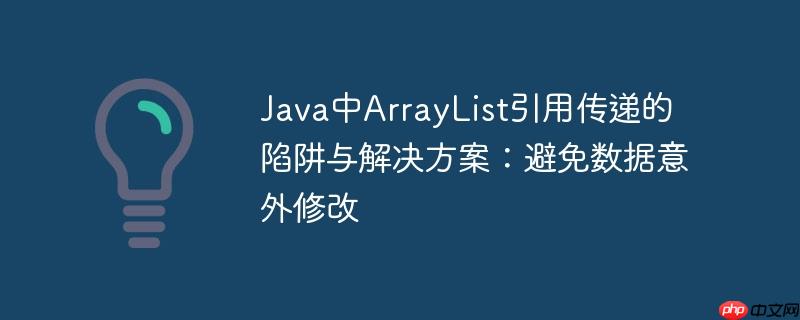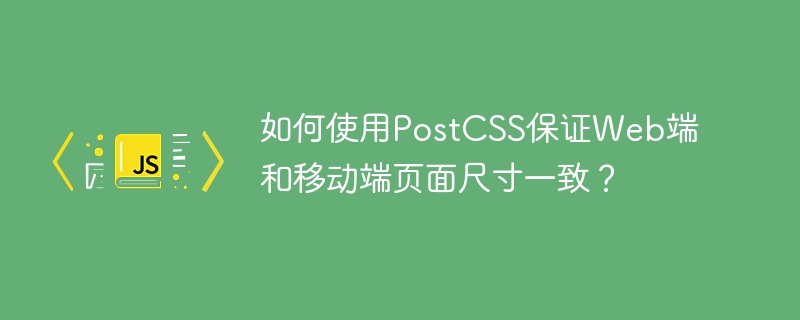
本文探讨了Java中ArrayList在对象创建时因引用传递导致的常见数据共享问题。当同一个ArrayList实例被重复使用并清空后,所有引用它的对象的数据会意外同步更新。核心解决方案是在每次需要独立数据时,重新实例化一个新的ArrayList对象,确保每个对象持有其专属的数据副本,从而避免数据混淆和非预期修改。
理解Java中的引用传递
在java中,对象(包括arraylist)的变量实际上存储的是对堆内存中实际对象的引用。当我们把一个对象作为参数传递给方法,或者将其赋值给另一个变量时,传递的都是这个对象的引用,而不是对象本身的一个副本。
这意味着,如果多个变量或对象引用了同一个ArrayList实例,那么通过其中任何一个引用对ArrayList进行的操作(例如添加、删除元素),都会影响到所有引用该ArrayList的变量或对象。
在原始代码示例中,问题就出在这里:
ArrayList<String> c = new ArrayList<String>(); // ... 添加选项 ... q.add(new Question("Geography","Which ocean is the largest?", c, "Pacific", "...")); // 此时,Question对象内部存储的是对变量c所指向的ArrayList实例的引用。 c.removeAll(c); // 清空了变量c所指向的那个ArrayList实例中的所有元素。 // 由于Question对象持有的是同一个ArrayList实例的引用, // 因此它的choices列表也会被清空。 // ... 添加新的选项 ... q.add(new Question("Geography", "How many countries are in the world?", c, "195", "...")); // 此时,第一个Question对象的choices列表,也变成了第二个Question对象的choices。
c.removeAll(c) 操作清空的是c当前指向的ArrayList对象的内容。由于之前创建的Question对象内部也持有对这个同一个ArrayList对象的引用,所以当c被清空或修改时,所有引用它的Question对象的choices列表都会同步更新,导致数据混乱。
解决方案:每次实例化新的ArrayList
要解决这个问题,最直接且推荐的方法是确保每个Question对象都拥有其自己独立的ArrayList实例作为choices列表。这意味着在为每个Question对象准备选项时,都应该创建一个全新的ArrayList实例,而不是重用并清空之前的实例。
立即学习“Java免费学习笔记(深入)”;
将代码中的 c.removeAll(c); 替换为 c = new ArrayList<String>(); 即可实现这一点。每次 c = new ArrayList<String>(); 执行时,都会在堆内存中创建一个全新的ArrayList对象,并让变量c指向这个新对象。这样,之前创建的Question对象仍然持有对旧ArrayList的引用,而新的Question对象则会持有对新ArrayList的引用,两者互不影响。
修正后的代码示例
以下是根据上述解决方案修正后的 allInitialQuestions 方法:
import java.util.ArrayList; import java.util.List; // 假设Question构造函数接受List<String> // 假设Question类定义如下(简化示例) class Question { String genre; String questionText; List<String> choices; // 使用List接口更通用 String answer; String funFact; public Question(String genre, String questionText, List<String> choices, String answer, String funFact) { this.genre = genre; this.questionText = questionText; // 注意:这里为了防止外部修改,通常会进行防御性复制 // 但在这个特定场景下,我们已经确保了传入的是新实例,所以直接赋值也无妨 this.choices = choices; this.answer = answer; this.funFact = funFact; } // Getter方法(省略) public List<String> getChoices() { return choices; } @Override public String toString() { return "Question{" + "genre='" + genre + ''' + ", questionText='" + questionText + ''' + ", choices=" + choices + ", answer='" + answer + ''' + ", funFact='" + funFact + ''' + '}'; } } public class Database { // 假设这是包含allInitialQuestions方法的类 public static ArrayList<Question> allInitialQuestions(ArrayList<Question> q) { ArrayList<String> c; // 声明变量,每次使用前重新实例化 // 第一个问题:海洋 c = new ArrayList<String>(); // 创建新的ArrayList实例 c.add("Pacific"); c.add("Atlantic"); c.add("Arctic"); c.add("Indian"); q.add(new Question("Geography","Which ocean is the largest?", c, "Pacific", "The Pacific Ocean stretches to an astonishing 63.8 million square miles!")); // 第二个问题:国家数量 c = new ArrayList<String>(); // 创建新的ArrayList实例 c.add("192"); c.add("195"); c.add("193"); c.add("197"); q.add(new Question("Geography", "How many countries are in the world?", c, "195", "Africa has the most countries of any continent with 54.")); // 第三个问题:最长河流 c = new ArrayList<String>(); // 创建新的ArrayList实例 c.add("Mississippi"); c.add("Nile"); c.add("Congo"); c.add("Amazon"); q.add(new Question("Geography", "What is the name of the longest river in the world?", c, "Nile","Explorer John Hanning Speke discovered the source of the Nile on August 3rd, 1858.")); // 第四个问题:人口最多国家 c = new ArrayList<String>(); // 创建新的ArrayList实例 c.add("United States"); c.add("China"); c.add("Japan"); c.add("India"); q.add(new Question("Geography","Which country has the largest population?" ,c, "China", "Shanghai is the most populated city in China with a population of 24,870,895.")); // 第五个问题:距离地球最近的行星 c = new ArrayList<String>(); // 创建新的ArrayList实例 c.add("Mars"); c.add("Mercury"); c.add("Venus"); c.add("Jupiter"); q.add(new Question("Geography","Which planet is closest to Earth?",c,"Venus","Even though Venus is the closest, the planet it still ~38 million miles from Earth!")); // 第六个问题:马里奥的创造者 c = new ArrayList<String>(); // 创建新的ArrayList实例 c.add("Sega"); c.add("Nintendo"); c.add("Sony"); c.add("Atari"); q.add(new Question("Video Games", "Which company created the famous plumber Mario?", c, "Nintendo", "Nintendo created Mario in 1981 for the arcade game Donkey Kong.")); // 第七个问题:蓝色刺猬角色 c = new ArrayList<String>(); // 创建新的ArrayList实例 c.add("Sonic"); c.add("Tales"); c.add("Knuckles"); c.add("Amy"); q.add(new Question("Video Games", "What is the name of the famous video character who is a blue hedgehog?",c,"Sonic", "In some official concept art, Sonic was originally meant to be a rabbit.")); // 第八个问题:最畅销游戏 c = new ArrayList<String>(); // 创建新的ArrayList实例 c.add("Wii Sports"); c.add("Grand Theft Auto V"); c.add("Tetris"); c.add("Minecraft"); q.add(new Question("Video Games","As of 2022, which of the following is the best selling video game of all time?",c,"Minecraft","As of 2022, Minecraft has sold over 238 million units.")); return q; } }
注意事项与最佳实践
- 理解引用与值传递: 这是Java编程中一个核心概念。基本数据类型(int, char, Boolean等)是按值传递的,而对象是按引用传递的。深刻理解这一点可以避免许多与数据共享相关的错误。
- 防御性复制(Defensive Copying): 在Question类的构造函数中,如果choices列表是从外部传入的,并且你希望Question对象内部的choices列表不被外部修改所影响,那么最佳实践是进行防御性复制。
public Question(String genre, String questionText, List<String> choices, String answer, String funFact) { // ... this.choices = new ArrayList<>(choices); // 创建传入列表的一个副本 // ... }这样,即使外部传入的choices列表在Question对象创建后被修改,Question对象内部的数据也不会受到影响。
- 不可变集合(Immutable Collections): 如果choices列表在Question对象创建后不应该被修改,可以考虑使用不可变集合。
- Java 9+ List.of(): List.of(“Pacific”, “Atlantic”, …) 可以直接创建不可变列表。
q.add(new Question("Geography", "Which ocean is the largest?", List.of("Pacific", "Atlantic", "Arctic", "Indian"), "Pacific", "...")); - Collections.unmodifiableList(): 可以将一个可变列表封装成不可变列表。
ArrayList<String> tempChoices = new ArrayList<>(); tempChoices.add("Pacific"); // ... q.add(new Question("Geography", "...", Collections.unmodifiableList(tempChoices), "...", "..."));使用不可变集合可以提高代码的健壮性和安全性,因为它从设计层面就防止了意外的数据修改。
- Java 9+ List.of(): List.of(“Pacific”, “Atlantic”, …) 可以直接创建不可变列表。
- 代码可读性: 明确地创建新对象比重用和清空旧对象更能清晰地表达代码意图。虽然创建新对象会有轻微的性能开销,但在绝大多数应用场景中,这种开销相对于代码的正确性、可维护性和可读性来说是微不足道的。
总结
在Java中处理集合对象时,务必警惕引用传递带来的数据共享问题。当需要为不同实体存储独立的数据集合时,核心原则是为每个实体提供其专属的集合实例。通过每次实例化新的ArrayList,或者采用防御性复制、不可变集合等策略,可以有效避免因引用共享导致的数据意外修改,从而确保程序的正确性和稳定性。

















